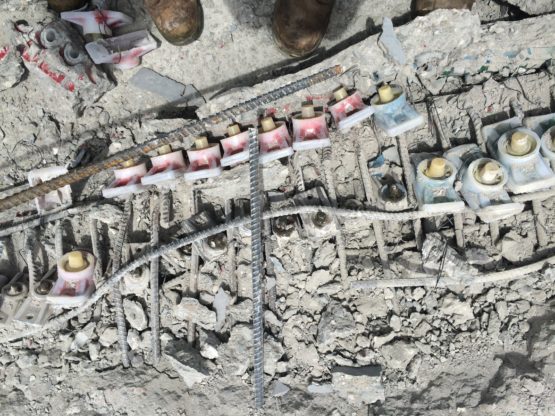Post-Tensioned Slab Blowout
CA investigated a large post-tensioning blowout which occurred during construction of a complicated, unique portion of a 30-story residential tower. CA’s investigation was focused on reviewing the design and construction of the Project, specifically the post-tensioned slabs, as well as documenting and analyzing the conditions and circumstances associated with the post-tensioning blowout and subsequent repair. CA determined that the structural design did not consider the complexity of the blowout location. No direction was provided regarding the anchorage placement with regard to the curved slab edge and the close proximity of the distributed and banded tendons. CA performed a finite element analysis which showed that the blowout location experienced overlapping bursting stresses from distributed tendons and the banded tendons. This, combined with restraint and an upward post-tensioning force, resulted in a localized region of amplified tensile stresses. These amplified stresses made the section susceptible to a post-tensioning blowout failure during construction. The repair of the blowout area incorporated numerous modifications as compared to the original design, including the relocation of the distributed tendons away from the banded tendon anchorages. During the repair, the blowout did not re-occur, confirming that the cause and/or contributing factors related to the design had been eliminated and addressed.
CA investigated a large post-tensioning blowout which occurred during construction of a complicated, unique portion of a 30-story residential tower. CA’s investigation was focused on reviewing the design and construction of the Project, specifically the post-tensioned slabs, as well as documenting and analyzing the conditions and circumstances associated with the post-tensioning blowout and subsequent repair. CA determined that the structural design did not consider the complexity of the blowout location. No direction was provided regarding the anchorage placement with regard to the curved slab edge and the close proximity of the distributed and banded tendons. CA performed a finite element analysis which showed that the blowout location experienced overlapping bursting stresses from distributed tendons and the banded tendons. This, combined with restraint and an upward post-tensioning force, resulted in a localized region of amplified tensile stresses. These amplified stresses made the section susceptible to a post-tensioning blowout failure during construction. The repair of the blowout area incorporated numerous modifications as compared to the original design, including the relocation of the distributed tendons away from the banded tendon anchorages. During the repair, the blowout did not re-occur, confirming that the cause and/or contributing factors related to the design had been eliminated and addressed.








